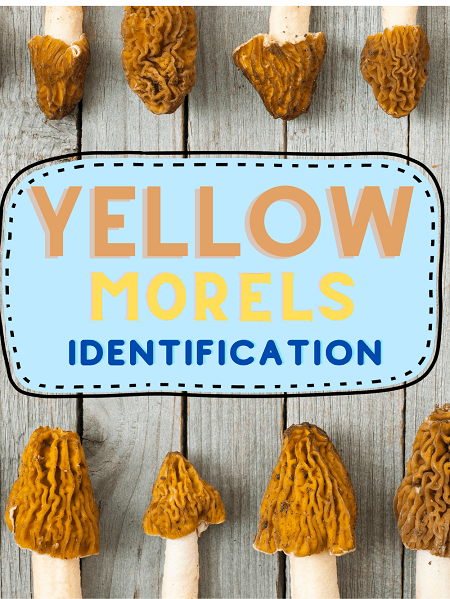The yellow morel, also well known as the common morel, is one of the most sought-after fungi there are. While they are also the most common morels, they are much like their rarer counterparts in that their growing season is short.
They are very dependent on the weather as well!

There are five types of yellow morels overall, and they can be a bit tricky to tell apart. However, in certain areas, it may be easier as there may only be one probable option! Let’s learn more!
What Do Yellow Morels Look Like?
Yellow morels are like all, they have a stubby white stem and an odd, tall, conical/ egg-shaped cap that is honeycombed. If you look closely, the cap fits around the stem much like a hat pulled down a person’s head!
The cap and stem are hollow, making the whole mushroom hollow from top to bottom, this sets it apart from its many look-alikes. The stem and cap attach at the lowest point and this can easily be dislodged if they are overhandled.
These mushrooms can be found solo, scattered across broad areas, or growing in groups. If you see one, look around for more, as there are usually more, even if they are far apart.
The 5 Yellow Morels
There are 5 types of yellow morels to look out for. Let’s look into each individually.

Morchella Americana / M. Esculentoides
This is the mode widespread of all morel species in North America. It is found from the East coast to the West coast, in the North, and in the South.
It is the largest of yellow morels and its shape resembles an egg, with a cap that is almost round sometimes.
The cap can be from 2.5-11cm tall and around 1.5-6cm wide! Its pits and ridges range from gray to dark brown, and as it has pits when young it is often referred to as the gray morel by foragers.
Yet, as it ages, the ridges and puts turn a yellow-brown color.
The stem stands 2-12cm tall and 1.5-10cm wide, with a swollen base. It can grow large if it is left undisturbed.
This morel grows with apple trees, ash trees, cottonwoods, and other hardcoods. In areas to the east of the Rockies it is often found growing beneath ash or elm trees.
M.Cryptica
This morel looks almost identical to M.Americana, and it also grows in similar areas, making it very hard to tell apart. Luckily M.cryptica only grows in specific areas, so for most places, it is not an issue.
It can be found around the Great Lakes, from Illinois to Ontario, and down to Western Pennsylvania it can be found growing around its cousin.
However, in these areas, it is unlikely you could tell the difference between this morel and M.Americana.
This morel grows under ash trees, tulip trees, and ash trees, as well as similar hardwoods. Its cap can be 4 to 8cm tall, and 3-6cm wide, while it has a stem that can be 1.5-6cm wide, and 5-13cm tall! Like M.Americana it also has a swollen base.

M.Virginiana
This morel has its name because it only grows in the SouthEastern United States, it also uniquely seems to only appear around tulip trees as well. It likes coastal areas, riverbeds, sandy soils, and other drainage areas.
Its cap grows between 3-7cm tall and 2-3.5cm wide, and its puts and ridges align vertically in a beautiful fashion.
When it is young its ridges will appear yellow, with little gray pits, and as it ages, they will turn a brown-yellow color, but the pits stay the same.
It has a stem that can reach 1-2cm in width and is 2.5-6cm tall, its base is only slightly swollen also, unlike the previous two!
M.Diminutiva
This morel gained its name from its small size in comparison to other yellow morel types. Its small size is its primary distinguishing feature. Its cap is short, however, it has skinnier and longer stems in comparison to others.
M.Diminutiva is often found to the East of the Great Plains and South of the Great Lakes. It prefers to grow around hickory, ash, tulip, and oak trees.
It is tiny, with a cap only 2-4cm tall, and 1-3cm wide! When it is young its ridges are yellow and the pits are a very dark grey, but as it gets older, the whole morel turns a brown-yellow color.
Its stem is also very tiny, being 0.5-1.5cm wide and 1-7cm tall!
M.Prava
Finally, the last yellow morel is the M.Prava, which can be found in Southern Canada and the Northern United States.
It prefers the sandy soils found around lakes and rivers, beneath oak and pine trees. Yet, it is also found in other places and is actually widely dispersed.
It is medium-sized, with a cap that is 3-6cm tall and 2.5cm wide. It has random ridges and pits.
Its ridges appear light yellow or even white in youth, but it has dark gray to black pits. However, when it is older the whole morel turns yellow-brown.
This morel is also unique as it stays in its immature stage for a lot longer than other morels and retains the gray pits.
Its stem is often 2.5-4cm tall, but 1-3cm wide, with a base ever-so-slightly swollen.
FAQs:
How Big Is A Yellow Morel?
There are 5 types of yellow morel, however, the cap averages at 6-10cm tall, with a cap width averaging at around 4cm.
How Much Are Yellow Morels Worth?
Yellow morels have an earthy yet nutty flavor, making them a unique but tantalizing treat.
- Edible Mushrooms In Colorado: Forager’s Guide - August 22, 2023
- A List Of 11 Weird Mushrooms (Facts And Looks) - August 14, 2023
- What Trees Do Morels Grow Under? Explained - June 25, 2023

![Identifying Gray Morels [A Guide] Identifying Gray Morels](https://learnfungus.com/wp-content/uploads/2023/03/Gray-morels-min-150x150.png)






